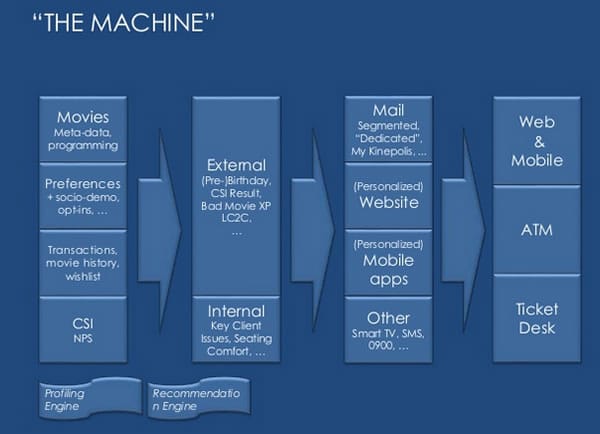Customer – and thus customer experience – is king for Kinepolis. The company combines a Customer Satisfaction Index and Net Promoter Score. Customer satisfaction and CX in marketing explained in a case.
Kinepolis is a Belgium-based yet internationally active player in the cinema industry. Although that definition is a bit too narrow: launched in 1997, the company is known for its so-called “multiplexes” and it offers more than movies.
Kinepolis, with activities in Belgium, France, Spain, Poland and Switzerland, for instance also has business-to-business activities (e.g. events) and offers “content” you won’t find in many other movie theaters. Just one example: operas that are streamed live from the Metropolitan in New York.
Stefaan Claes, CRM & Digital Marketing Manager at the Kinepolis Group, explained how the company moved towards preference-driven marketing at one of i-SCOOP’s events, the Fusion Marketing Experience. NPS plays a key role in it.

NPS on the brand level and the individual product level
The customer experience and customer satisfaction take center stage in Kinepolis’ approach. Inevitably this means data, metrics and analytics.
Before Stefaan joined the company, Kinepolis already used a Customer Satisfaction Index (CSI). Stefaan added Net Promoter Score (NPS) to that CSI, first on a brand level and later for the movies and other content individually.

For its CSI the company works with two lists of questions. One set is very exhaustive and looks at really each aspect of the customer experience: ranging from the quality of the seats to the sound experience.
When people come back to see a movie within the same month, the experience regarding that movie and the likeliness to recommend are gauged. Using NPS Kinepolis, which employes 2100 people on 34 sites, knows what customers think about a specific movie.
According to Stefaan this offers a much stronger approach than gathering more general opinions and input. By leveraging NPS scores the company can also proactively recommend movies or, the other way around, protect customers from disappointments.
Understanding the why of NPS scores – building a recommendation engine
And this is where the “why” behind the NPS scores comes in. Why do people rate a movie with a specific score? It’s at least as important as the score itself.
An example: you might like a specific actor who is often casted for similar roles or similar types of films
Let’s say you watched a big commercial action blockbuster with Johnny Depp or Brad Pitt and you highly would recommend it. Why would you? Is it because you like big action movies? Is it because you’re a fan of Depp or Pitt? And if you are a fan, have you only seen their commercial blockbusters or did you also see their other movies that appeal to smaller audiences?
Knowing this is important for future (personalized) recommendations. If you’re a big Brad Pitt fan but are not exactly a fan of movies like “The Mexican” or “Twelve Monkeys” or haven’t seen them you might live a bad experience if you’re recommended to watch a new Pitt movie that is totally outside of your ‘preference zone’ or even comfort zone.
Same thing with Depp: maybe you liked the “Pirates” movies but would never watch an entirely different movie with Depp such as Charlie and the Chocolate factory, Edward Scissorhands or Chocolat, with Juliette Binoche. Anyway, you get the picture (no pun intended).
Relevance as a religion
At a recent event, Stefaan shared the case. Stefaan’s presentation, titled ‘Relevance is a religion’ shows how the corporate CRM and digital marketing team works with a center of expertise across the various (digital) channels and apps the company uses (Kinepolis also has been an early adopter of social listening).
It also tackles the place of preferences, the Customer Satisfaction Index (and NPS), digital and marketing automation within the broader Kinepolis “machine” as depicted above.
The presentation clearly shows the various tactics and interactions and how the company moves towards an ever more “relevant” and preference-driven model in practice, obviously with a strong data-driven component. You can watch it below and check out Kinepolis here.

